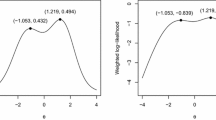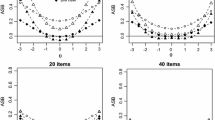Abstract
A definition ofessential independence is proposed for sequences of polytomous items. For items satisfying the reasonable assumption that the expected amount of credit awarded increases with examinee ability, we develop a theory ofessential unidimensionality which closely parallels that of Stout. Essentially unidimensional item sequences can be shown to have a unique (up to change-of-scale) dominant underlying trait, which can be consistently estimated by a monotone transformation of the sum of the item scores. In more general polytomous-response latent trait models (with or without ordered responses), anM-estimator based upon maximum likelihood may be shown to be consistent for θ under essentially unidimensional violations of local independence and a variety of monotonicity/identifiability conditions. A rigorous proof of this fact is given, and the standard error of the estimator is explored. These results suggest that ability estimation methods that rely on the summation form of the log likelihood under local independence should generally be robust under essential independence, but standard errors may vary greatly from what is usually expected, depending on the degree of departure from local independence. An index of departure from local independence is also proposed.
Similar content being viewed by others
References
Anastasi, A. (1988).Psychological testing (6th ed.). New York: Macmillan.
Ash, R. B. (1972).Real analysis and probability. New York: Academic Press.
Birnbaum, A. (1968). Some latent trait models and their use in inferring an examinee's ability. In Lord, F. M. & M. R. Novick,Statistical theories of mental test scores. Reading, MA: Addison-Wesley.
Bock, R. D. (1972). Estimating item parameters and latent ability when the responses are scored in two or more nominal categories.Psychometrika, 37, 29–51.
Bock, R. D., & Mislevy, R. J. (1982). Adaptive EAP estimation of ability in a microcomputer environment.Applied Psychological Measurement, 6, 431–444.
Bradley, R. C. (1985). Counterexamples to the central limit theorem under strong mixing conditions. In P. Revesz (Ed.),Colloquia mathematica societitas Janos Bolyai 36. Limit theorems in probability and statistics, Veszprem (Hungary), 1982. Volume I (pp. 153–172). Amsterdam: North-Holland.
Bradley, R. C. (1989). A stationary, pairwise independent, absolutely regular sequence for which the central limit theorem fails.Probability Theory and Related Fields, 81, 1–10.
Drasgow, F., & Parsons, C. K. (1983). Application of unidimensional item response theory models to multidimensional data.Applied Psychological Measurement, 7, 189–199.
Dvoretzky, A. (1972). Asymptotic normality for sums of dependent random variables.Proceedings of the sixth Berkeley symposium on mathematical probability and statistics, 2, 513–535.
Foutz, R. V. (1977). On the unique consistent solution to the likelihood equations.Journal of the American Statistical Association, 72, 147–148.
Gibbons, R. D., R. D. Bock, & D. R. Hedeker (1989).Conditional dependence (Final Research Report). Chicago, IL: University of Illinois at Chicago, Office of Naval Research and Illinois State Psychiatric Institute.
Holland, P. W., & Rosenbaum, P. R. (1986). Conditional association and unidimensionality in monotone latent trait models.Annals of Statistics, 14, 1523–1543.
Jannarone, R. J. (1986). Conjunctive item response theory kernels.Psychometrika, 51, 357–373.
Jogdeo, K. (1978). On a probability bound of Marshall and Olkin.Annals of Statistics, 6, 232–234.
Junker, B. W. (1988).Statistical aspects of a new latent trait model. Unpublished doctoral dissertation, University of Illinois at Urbana-Champaign, Department of Statistics.
Lehmann, E. L. (1983).Theory of point estimation. New York: Wiley.
Levine, M. V. (1989).Ability distributions, pattern probabilities, and quasidensities (Final Research Report). Champaign, IL: University of Illinois at Urbana-Champaign, Office of Naval Research and Model-Based Measurement Laboratory.
Lord, F. M. (1980).Applications of item response theory to practical testing problems. Hillsdale, NJ: Lawrence Erlbaum.
Lord, F. M. (1986). Maximum likelihood and Bayesian parameter estimation in item response theory.Journal of Educational Measurement, 23, 157–162.
Nandakumar, R. (1990). Traditional dimensionality versus essential dimensionality.Journal of Educational Measurement, 28, 99–117.
Rosenbaum, P. R. (1988). Item bundles.Psychometrika, 53, 349–359.
Samejima, F. (1969). Estimation of latent ability using a response pattern of graded scores.Psychometrika Monograph No. 17, 24(4, Pt. 2).
Samejima, F. (1972). A general model for free-response data.Psychometrika Monograph No. 18, 37(4, Pt. 2).
Samejima, F. (1973). A comment of Birnbaum's three parameter logistic model in the latent trait theory.Psychometrika, 38, 221–233.
Serfling, R. J. (1980).Approximation theorems in mathematical statistics. New York: Wiley.
Spray, J. A., & Ackerman, T. A. (1987).The effect of item response dependence on trait or ability dimensionality (ACT Research Report Series ♯87-10). Iowa City, IA: ACT.
Stout, W. F. (1987). A nonparametric approach for assessing latent trait unidimensionality.Psychometrika, 52, 589–617.
Stout, W. F. (1990). A new item response theory modeling approach with applications to unidimensionality assessment and ability estimation.Psychometrika, 55, 293–325.
Thissen, D., & Steinberg, L. (1986). A taxonomy of item response models.Psychometrika, 51, 567–577.
Tsutakawa, R. K. & Soltys, M. J. (1988). Approximation for Bayesian ability estimation.Journal of Educational Statistics, 13, 117–130.
Wainer, H. & Wright, B. D. (1980). Robust estimation of ability in the Rasch model.Psychometrika, 45, 373–391.
Walker, A. M. (1969). On the asymptotic behaviour of posterior distributions.Journal of the Royal Statistical Society, Series B, 31, 80–88.
Author information
Authors and Affiliations
Additional information
This work was supported in part by Office of Naval Research Grant N00014-87-K-0277 and National Science Foundation Grant NSF-DMS-88-02556. The author is grateful to William F. Stout for many helpful comments, and to an anonymous reviewer for raising the questions addressed in section 2. A preliminary version of section 6 appeared in the author's Ph.D. thesis.
Rights and permissions
About this article
Cite this article
Junker, B.W. Essential independence and likelihood-based ability estimation for polytomous items. Psychometrika 56, 255–278 (1991). https://doi.org/10.1007/BF02294462
Received:
Revised:
Issue Date:
DOI: https://doi.org/10.1007/BF02294462




